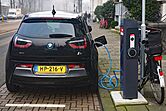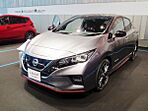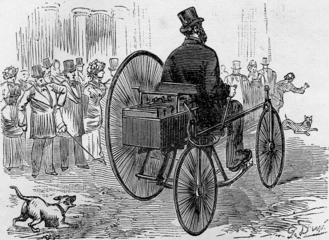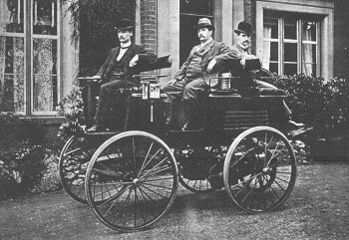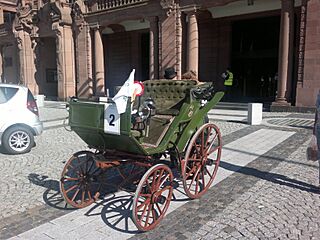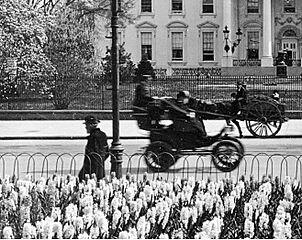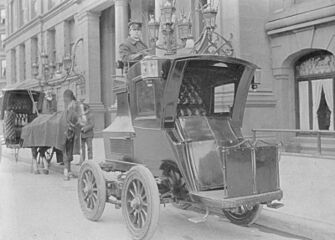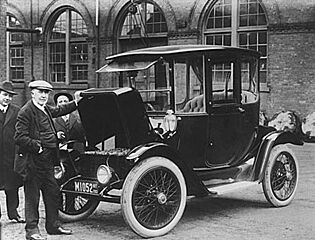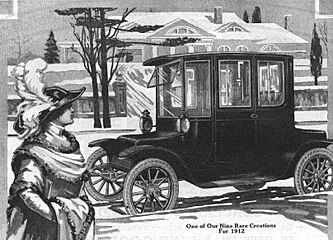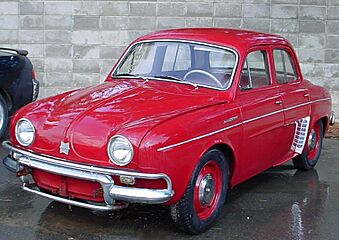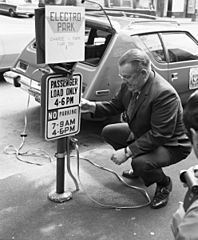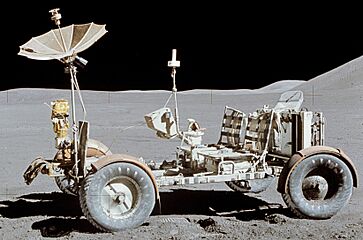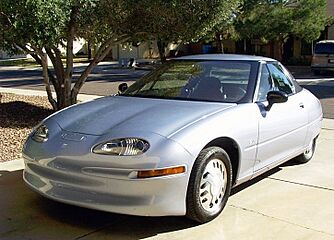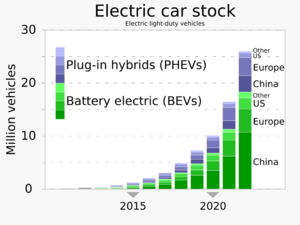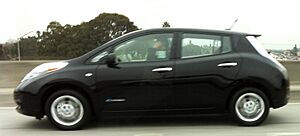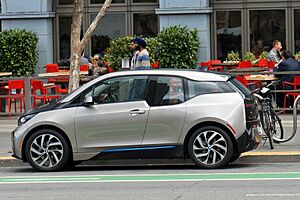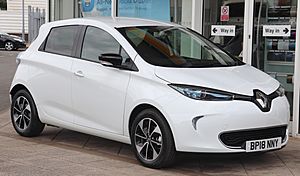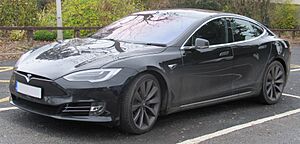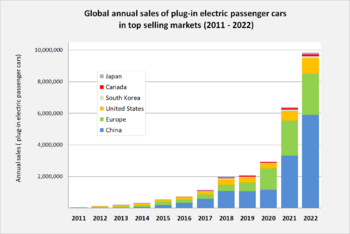History of the electric vehicle facts for kids
Electric cars have a long and interesting history! The very first simple electric vehicles were created in the late 1820s and 1830s. By the 1890s, practical electric cars were available to buy. For a short time around 1900, an electric car even held the world record for land speed!
However, in the early 1900s, electric cars became less popular. They were expensive, didn't go very fast, and couldn't travel far on one charge. Cars with gasoline engines became cheaper and could go much further. So, electric cars were mostly used for things like moving goods or for public transport like trains.
At the start of the 21st century, people became interested in electric cars again. This was because of worries about air pollution from gasoline cars and how long fossil fuels would last. Also, electric car technology had gotten much better.
Since 2010, electric car sales have grown a lot. By the end of 2020, over 10 million light-duty electric cars had been sold worldwide. The Tesla Model 3 is the best-selling electric car of all time, with about 645,000 units sold by August 2020.
Contents
- Early Electric Inventions
- First Full-Scale Electric Cars
- 1890s-1910s: The Golden Age
- 1920s–1950s: The Decline of Electric Cars
- 1960s–1990s: A New Interest in Electric Cars
- 2000s: Modern Highway Electric Cars
- 2010s: Electric Cars Take Off
- 2020s: Rapid Growth
- Electric Bicycles
- Timeline of Milestones
- Notable Electric Cars
- See also
Early Electric Inventions
Electric Model Cars
Ideas for electric vehicles came from early electric motor designs. In 1828, a Hungarian priest named Ányos Jedlik invented an early electric motor. He used it to power a small model car.
Between 1832 and 1839, a Scottish inventor named Robert Anderson also made a simple electric carriage. In 1835, Professor Sibrandus Stratingh and his assistant Christopher Becker from Germany created a small electric car. It ran on batteries that couldn't be recharged.
Electric Locomotives
In 1834, an American blacksmith named Thomas Davenport built a similar machine. It ran on a short, round, electrified track. The first known electric train was built in Scotland in 1837 by a chemist named Robert Davidson. It was powered by batteries.
Davidson later built a bigger train called Galvani. It weighed about 7 tons and could pull a 6-ton load at 4 miles per hour for 1.5 miles. It was tested on a railway in Scotland in 1842. However, the batteries weren't powerful enough for regular use. Railway workers even destroyed it because they thought it would take their jobs!
In 1840, a patent was given in England for using train tracks to carry electricity. Similar patents were given in the United States in 1847. The first battery-powered train car was used in Germany in 1887.
First Full-Scale Electric Cars
Rechargeable batteries were a big step forward for electric vehicles. In 1859, French physicist Gaston Planté invented the lead–acid battery. Another French scientist, Camille Alphonse Faure, made the battery much better in 1881. This led to them being made in large numbers.
The first electric vehicle that could carry a person and had its own power source was tested in Paris in April 1881. It was made by French inventor Gustave Trouvé. He improved a small electric motor and put it on an English tricycle. This created the world's first electric car. He couldn't patent it, but he quickly used his motor to power a boat, inventing the outboard motor.
In 1884, English inventor Thomas Parker built his first electric car in England. He was known for electrifying the London Underground. Parker was interested in making cars that used less fuel. His company, Elwell-Parker, later became the Electric Construction Corporation. This company had a strong hold on the British electric car market in the 1890s.
France and the United Kingdom were the first countries to really develop electric vehicles. German engineer Andreas Flocken built the first true electric car in 1888.
Electric trains were also used to carry coal out of mines. Their motors didn't use up precious oxygen. Before gasoline engines became popular, electric cars held many speed records. On April 29, 1899, Camille Jenatzy broke the 100 km/h (62 mph) speed barrier in his electric car, Jamais Contente, reaching 105.88 km/h (65.79 mph). Ferdinand Porsche also designed an electric car with a motor in each wheel, which set records.
The first electric car in the United States was made in 1890–91 by William Morrison from Iowa. It was a wagon for six people and could go 14 mph (23 km/h). People started paying attention to electric cars in the U.S. in 1895.
-
Gustave Trouvé's tricycle (1881), the world's first electric car.
1890s-1910s: The Golden Age
Interest in cars grew a lot in the late 1890s and early 1900s. Electric taxis appeared in cities like London and New York. In London, Walter Bersey introduced a fleet of electric cabs in 1897. They were called "Hummingbirds" because of the sound they made.
Electric cars had many good points compared to early gasoline cars. They didn't vibrate, smell, or make a lot of noise. They also didn't need gear changes. Gasoline cars had to be started with a hand crank, which was hard and sometimes dangerous. Electric cars just started with a switch.
Wealthy people liked electric cars for driving in the city. Their limited range wasn't a problem for short trips. By the early 1900s, 38% of cars in the United States were electric. The U.S. had the most electric cars in the world.
Early electric vehicles were often fancy carriages with luxurious interiors. They were sometimes marketed as luxury cars for women. Sales of electric cars were highest in the early 1910s. Over 300 companies made electric vehicles in the U.S. until 1942.
In the 1910s, the Standard Electric car used Westinghouse motors. It claimed to go 110 miles on one charge. It had a top speed of 20 mph. The Beardsley Electric Company made 661 electric cars between 1914 and 1917. A typical Beardsley car could travel about 70 miles.
Battery Swapping Services
To help with the limited range of electric cars, people thought of swapping batteries. This idea was first tried in 1896 by the Hartford Electric Light Company. They offered a battery service for electric trucks. Owners bought the truck without a battery and paid a fee to use and swap batteries. This service ran from 1910 to 1924 and covered over 6 million miles.
In New York City, before World War I, electric car companies worked together. They included General Motors' truck division and General Electric's General Vehicle division. They had almost 2,000 electric vehicles in the city. Even a big department store, Lord and Taylor, proudly used 38 electric trucks for deliveries.
-
Thomas Edison and an electric car in 1913.
1920s–1950s: The Decline of Electric Cars
After their early success, electric cars started to lose their popularity. Roads improved, and people wanted to travel further. Electric cars were slow (15–20 mph) and had a short range (30–40 miles). Gasoline cars could go much faster and further.
Gasoline cars also got better. In 1912, Charles Kettering invented the electric starter. This meant gasoline cars no longer needed a dangerous hand crank to start. The muffler, invented in 1897, made gasoline engines much quieter.
Most importantly, Henry Ford started making gasoline cars on an assembly line. This made them much cheaper. By 1912, an electric car cost almost twice as much as a gasoline car.
Most electric car makers stopped production in the 1910s. Electric vehicles still found uses where their limited range wasn't a problem. Forklift trucks became electric in 1923. In Europe, especially the UK, electric milk floats were common for deliveries. For most of the 20th century, most battery electric road vehicles in the world were British milk floats. Electric golf carts were also produced starting in 1954. By the 1930s, the electric car industry had mostly disappeared.
Years passed without electric cars making a big comeback. During World War II, some European countries experimented with electric cars because fuel was scarce. However, gasoline car technology kept improving rapidly, while electric car technology didn't. In the late 1950s, the Henney Kilowatt electric car was made. It could go almost 60 mph and travel for nearly an hour. But it cost twice as much as a gasoline car, so production ended in 1961.
1960s–1990s: A New Interest in Electric Cars
In the mid-1960s, some electric concept cars appeared, like the Scottish Aviation Scamp (1965) and the electric Electrovair (1966). But none of them were mass-produced. The Enfield 8000 (1973) was made in small numbers.
A very special electric car was the Lunar Roving Vehicle. On July 31, 1971, it became the first vehicle driven by humans on the Moon during the Apollo 15 mission! This "Moon buggy" had an electric motor in each wheel and special batteries.
After years of being forgotten, the energy crises of the 1970s and 1980s made people interested in electric cars again. They offered freedom from changing gasoline prices. However, many electric cars from this time, like the Sinclair C5, were not successful.
In 1990, General Motors showed off the GM Impact electric concept car. They announced they would build electric cars for the public. From the 1960s to the 1990s, some companies converted existing car models into electric ones. These were not sold in large numbers because they were expensive and had limited range. Most were sold to government groups and electric companies.
In the early 1990s, California's clean air agency, the California Air Resources Board (CARB), pushed for cleaner cars. They wanted to move towards zero-emissions vehicles like electric cars. In response, carmakers developed electric models. These included the Chrysler TEVan, Ford Ranger EV pickup, GM EV1, Honda EV Plus, Nissan Altra EV, and Toyota RAV4 EV. The Nissan Altra was important because it was the first production electric car to use lithium-ion batteries.
Some people felt that carmakers didn't truly want to sell these electric cars. For example, GM only leased the EV1s and didn't let people buy them. After the leases ended, the cars were taken back by GM. Many were later destroyed. This made electric car fans very upset.
During the 1990s, Americans became less interested in fuel-efficient cars. They preferred larger sport utility vehicles because gasoline was cheap. Most electric vehicles on the roads were slow, short-range neighborhood electric vehicles (NEVs). By 2011, there were almost 479,000 NEVs worldwide.
-
A charging station for an electric AMC Gremlin used by Seattle City Light in 1973.
-
Three Lunar Roving Vehicles are still on the Moon today.
2000s: Modern Highway Electric Cars
In 2004, California electric car maker Tesla Motors started developing the Tesla Roadster. It was first delivered to customers in 2008. The Roadster was the first electric car that could travel more than 200 miles on a single charge. Tesla sold about 2,450 Roadsters until early 2012.
The Mitsubishi i-MiEV was launched in Japan for businesses in July 2009. It became available to individual customers in April 2010. It was also sold in Europe as the Peugeot iOn and Citroën C-Zero. By the end of 2012, Mitsubishi had sold or exported about 27,200 i-MiEVs.
Leaders at big car companies like Nissan and General Motors said that the Tesla Roadster showed that people really wanted more efficient cars. Bob Lutz, a GM vice-chairman, said that Tesla proved that advanced electric car technology was possible, even for a small startup.
2010s: Electric Cars Take Off
The Nissan Leaf was introduced in Japan and the United States in December 2010. It was the first modern, all-electric family car made for the mass market by a major car company. By January 2013, the Leaf was available in many countries.
The Better Place network tried a new idea: battery swapping. The Renault Fluence Z.E. was the first mass-produced electric car with a swappable battery. Better Place launched its first battery-swapping station in Israel in March 2011. Swapping a battery took only five minutes. However, Better Place faced financial problems and went bankrupt in 2013.
Other electric cars launched around this time included the Smart electric drive, Ford Focus Electric, and BYD e6. In February 2011, the Mitsubishi i-MiEV became the first electric car to sell over 10,000 units. A few months later, the Nissan Leaf became the best-selling all-electric car ever. By February 2013, global sales of the Leaf reached 50,000 units.
The next Tesla car, the Model S, was released in the U.S. in June 2012. It later launched in Europe and China. Other models released in 2012 and 2013 included the Renault Zoe, BMW i3, and Volkswagen e-Up!. The Coda electric sedan stopped production in 2013 after selling only about 100 units.
The Tesla Model S was the top-selling plug-in electric car in North America in early 2013. When it launched in Norway in August 2013, it became the best-selling car there for a month. This was the first time an electric car topped new car sales in any country.
The Renault–Nissan Alliance sold 100,000 all-electric vehicles by July 2013. By January 2014, global sales of the Nissan Leaf reached 100,000 units.
By June 2014, there were over 500,000 plug-in electric cars and vans worldwide. The U.S. led sales, followed by China and Japan. In September 2014, U.S. sales of plug-in electric cars reached 250,000 units. The Tesla Model S passed 50,000 units sold globally by October 2014.
The world's best-selling all-electric cars in 2014 were the Nissan Leaf, Tesla Model S, BMW i3, and Renault Zoe. New all-electric models released in 2014 included the Kia Soul EV and Volkswagen e-Golf.
In May 2015, global sales of highway-legal all-electric cars and light vans passed 500,000 units. Nissan, Tesla, and Mitsubishi accounted for most of these sales. By mid-September 2015, the global sales of plug-in electric passenger cars and vans passed one million units. Pure electric cars made up about 62% of these sales.
By December 2015, the Nissan Leaf was the world's top-selling highway-capable electric car ever, with over 200,000 units sold. The Tesla Model S was the second best-selling, with over 100,000 units.
The Tesla Model 3 was shown on March 31, 2016. It was priced at $35,000 and could go over 215 miles on a charge. It was Tesla's first car aimed at the mass market. Before it was even shown, over 115,000 people had reserved one! By May 2016, there were about 373,000 reservations.
The Hyundai Ioniq Electric was released in South Korea in July 2016. The Renault-Nissan Alliance sold 350,000 electric vehicles globally by August 2016. Nissan's global electric vehicle sales passed 250,000 units, and Renault's passed 100,000 units.

Total global sales of pure electric cars and vans passed one million units in September 2016. The Tesla Model S reached 150,000 units sold by November 2016. Norway became the first country where 5% of all registered cars were plug-in electric cars in December 2016. The Chevrolet Bolt EV, with a 238-mile range, began deliveries in December 2016.
In January 2017, Norway set a record: 37.5% of new car sales were plug-in electric cars. For the first time, electric and hybrid cars together sold more than gasoline or diesel cars in Norway. This was partly because Norway offered many benefits for electric vehicles, like subsidies and free parking.

In February 2017, Consumer Reports named Tesla the top car brand in the U.S. Global sales of the Nissan Leaf reached 300,000 units in January 2018.
In September 2018, Norway set another record: 60.2% of new car sales were plug-in electric cars! By October 2018, Norway became the first country where 1 in every 10 cars on the road was a plug-in electric vehicle. By the end of 2018, almost half of all new cars sold in Norway were plug-in electric.
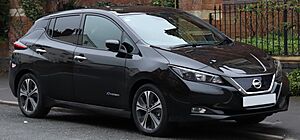
Tesla delivered its 100,000th Model 3 in October 2018. The Model 3 was the best-selling plug-in electric car in the U.S. for 12 months in a row. In 2018, it became the first plug-in car to sell over 100,000 units in a single year. The Nissan Leaf was Norway's best-selling new car model in 2018. The Tesla Model 3 was the world's best-selling plug-in electric car in 2018.
In January 2019, the Model 3 became the best-selling all-time electric car in the U.S. The Nissan Leaf was the world's best-selling electric car until 2019, with 450,000 units sold. The Tesla Model 3 ended 2019 as the world's best-selling plug-in electric car for the second year in a row.
By December 2018, there were 5.1 million plug-in electric cars worldwide. About 3.3 million were fully electric cars, and 1.8 million were plug-in hybrids. Even with this growth, plug-in electric cars were still only about 1 out of every 250 vehicles on the road.
2020s: Rapid Growth
The Tesla Model 3 passed the Nissan Leaf in early 2020 to become the world's best-selling electric car ever. By March 2020, over 500,000 Model 3s had been sold. Tesla also became the first car company to produce 1 million electric cars in March 2020. The Model 3 reached 1 million units sold globally in June 2021, the first electric car to do so.
The Nissan Leaf reached 500,000 units sold globally in December 2020, 10 years after it first came out. By the end of 2020, over 10 million plug-in electric cars and light vans had been sold worldwide since 2010. Just a year and a half later, in June 2022, this number doubled to 20 million! In May 2023, the Tesla Model Y became the world's best-selling vehicle overall in the first part of the year.
Electric Bicycles
Electric bicycles, or e-bikes, are also very popular. China is the biggest maker of e-bikes, producing 22.2 million units in 2009. China accounts for almost 92% of the world's e-bike market. In 2010, there were 120 million electric bicycles on the roads in China.
The first electric bicycle models appeared in the late 1800s. The U.S. Patent office registered several e-bike patents from 1895 to 1899. For example, Ogden Bolton patented a battery-powered bicycle in 1895.
Timeline of Milestones
| Date | Important Moments in Electric Vehicle History |
|---|---|
| 1875 | The world's first electric tram line started in Russia, invented by Fyodor Pirotsky. |
| 1881 | The world's first successful electric tram started in Germany, built by Werner von Siemens. |
| 1882 | The trolleybus was first shown by Dr. Ernst Werner Siemens in Berlin. |
| 1883 | The first electric tram powered by overhead wire started in Vienna, Austria. |
| 1884 | Thomas Parker built an electric car in England using his special batteries. |
| Dec 1996 | The limited production General Motors EV1 was launched. |
| 1998 | The Nissan Altra EV was launched. It was the first highway-legal electric car to use lithium-ion batteries. |
| Jul 2009 | The Mitsubishi i-MiEV was launched, the first modern mass-produced electric car. |
| Dec 2010 | Deliveries of the Nissan Leaf and Chevrolet Volt began. |
| 2011 | The Nissan Leaf became the world's best-selling all-electric car. |
| Jun 2012 | The Tesla Model S was launched. |
| Mar 2014 | 1% of all cars in Norway were plug-ins. |
| Sep 2015 | Global sales of plug-in cars passed 1 million units. |
| Nov 2016 | Global sales of all-electric cars and vans passed 1 million. |
| Dec 2016 | Total global plug-in sales passed 2 million units. |
| 5% of passenger cars on Norwegian roads were plug-ins. | |
| Early 2017 |
The 1 millionth new energy car was sold in China. |
| Jul 2017 | The Tesla Model 3 was launched. |
| Nov 2017 | Total global plug-in sales passed 3 million units. |
| Dec 2017 | Annual global sales passed 1 million units for the first time. |
| 5% of all cars in Norway were all-electric. | |
| Annual global market share for electric cars passed 1% for the first time. | |
| First half 2018 |
The 1 millionth plug-in electric car was sold in Europe. |
| Sep 2018 | The 1 millionth plug-in electric car was sold in the U.S. |
| The 2 millionth new energy vehicle was sold in China. | |
| Oct 2018 | 10% of passenger cars on Norwegian roads were plug-ins. |
| Nov 2018 | The 500,000th plug-in car was sold in California. |
| Dec 2018 | Annual global sales passed 2 million units. |
| The Tesla Model 3 became the first plug-in car to sell over 100,000 units in one year. | |
| Dec 2019 | One out of two new passenger cars sold in Norway in 2019 was a plug-in electric car. |
| Early 2020 |
The Tesla Model 3 became the world's best-selling plug-in electric car in history. |
| Mar 2020 | The Tesla Model 3 was the first electric car to sell over 500,000 units. |
| Tesla, Inc. became the first car maker to produce 1 million electric cars. | |
| Apr 2020 | 10% of all cars on the road in Norway were all-electric. |
| Dec 2020 | Nissan Leaf global sales reached 500,000 units. |
| Total global plug-in sales passed the 10 million unit milestone. | |
| The Norwegian plug-in car segment reached a record annual market share of 74.7% of new car sales. | |
| Over 15% of all cars on Norwegian roads were plug-in electric. | |
| June 2021 | Tesla Model 3 global sales passed 1,000,000 units. |
| May 2022 | Total global plug-in sales passed the 20 million unit milestone. |
| January 2023 | Electric vehicles reached over 10% of the global car market share. |
| May 2023 | The Tesla Model Y became the world's best-selling vehicle overall. |
Notable Electric Cars
Here are some important electric vehicles throughout history:
| Name | Years Made | Number Made | Range | What Made It Special |
|---|---|---|---|---|
| Baker Electric | 1899–1915 | About 50 miles (80 km) | One of the very first electric cars. It was the largest electric car maker in the world by 1906. | |
| Studebaker Electric | 1902–1912 | 1,841 | 30–80 miles (48–129 km) | Another early electric car. |
| Detroit Electric | 1907–1939 | 13,000 | About 80 miles (129 km) | Over 13,000 were made, making it one of the most successful early electric cars. |
| Henney Kilowatt | 1958–1960 | <100 | The first mass-produced electric car after they became less popular in the early 1900s. | |
| Sebring-Vanguard Citicar | 1974–1982 | 4,444 (including other versions) |
About 40 miles (64 km) | The most popular electric car of its time after World War II. |
| General Motors EV1 | 1996–2003 | 1,117 | About 160 miles (257 km) | The first electric car designed from scratch by a major car company in the modern era. |
| Honda EV Plus | 1997–1999 | ~300 | 80-110 miles (129-177 km) | The first known car from a major car maker to use NiMH batteries instead of lead-acid batteries. |
| Toyota RAV4 EV | 1997–2002 | 1,900 | About 87 miles (140 km) | The first electric vehicle sold to the public by Toyota. |
| REVAi | 2001–2012 | 4,000+ | About 50 miles (80 km) | |
| Tesla Roadster | 2008–2012 | 2,500 | About 220 miles (354 km) | The first vehicle made by Tesla, Inc.. |
| Mitsubishi i MiEV (Also sold as Peugeot iOn/Citroën C-Zero) |
2009– | 50,000 (by 2015) | About 62 miles (100 km) | The first very popular mass-produced electric vehicle (over 50,000 sold). |
| Nissan Leaf | 2010– | 470,000 (by 2020) | About 109 miles (175 km) | Became the most successful electric vehicle until the Tesla Model 3. Over 500,000 have been sold. |
| BYD F3DM | 2010-2013 | 3,284 | 60 miles (97 km) | The first mass-produced plug-in hybrid car. |
| Renault Kangoo Z.E. | 2011– | 50,000 (by 2020) | As of December 2019, it was the best-selling all-electric light commercial vehicle in Europe. | |
| Tesla Model S | 2012– | 200,000 (by 2017) | Up to 402 miles (647 km) | The first completely new design from Tesla, Inc.. |
| Renault Zoe | 2013– | 200,000 (by 2020) | Since 2020, it has been Europe's best-selling plug-in electric car ever. | |
| BMW i3 | 2013– | 165,000 (by 2020) | 80 to 100 miles (129 to 161 km) | The first electric car designed specifically as an electric car from BMW. |
| Chevrolet Bolt | 2017– | 51,600 (by 2018) | 238 miles (383 km) | |
| Tesla Model 3 | 2017– | More than 500,000 (by March 2020) |
220 miles (354 km) (Standard version), 310 miles (499 km) (Long Range version) |
The most successful electric car worldwide as of 2020. |
See also
 In Spanish: Historia del vehículo eléctrico para niños
In Spanish: Historia del vehículo eléctrico para niños
- History of the automobile
- History of plug-in hybrids
- List of production battery electric vehicles




